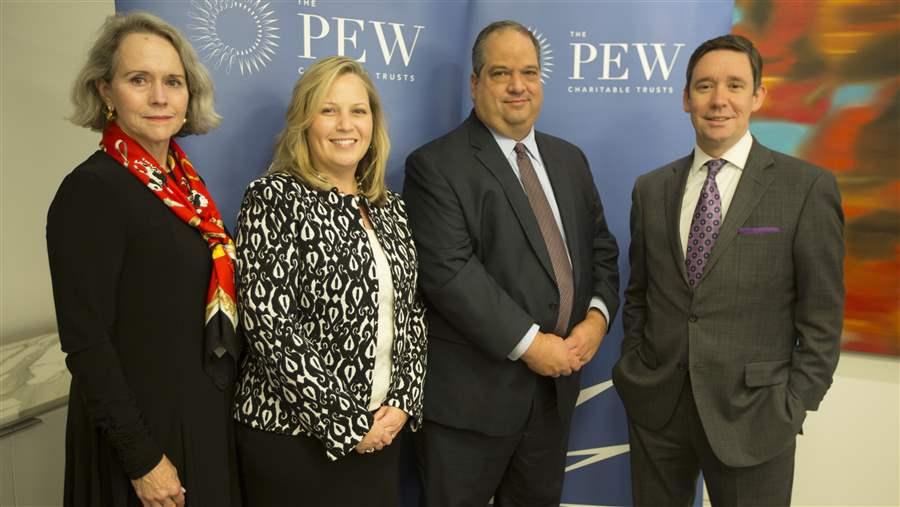Experts Discuss Disaster Preparedness After a Catastrophic Hurricane Season

The director of Pew’s flood-prepared communities project, Laura Lightbody, speaks with FEMA’s deputy associate administrator for insurance and mitigation, Roy Wright.
© The Pew Charitable TrustsThose interested in improving the United States’ preparation for major floods must move beyond discussing the issue to achieving lasting results, a senior Federal Emergency Management Agency (FEMA) official told the audience at this month’s Resilient Nation Partnership Network’s annual forum.
After 2017’s historically destructive hurricane season, “we have an opportunity to make a difference and not simply rerun the same conversations” by incorporating more flood mitigation activities into response, said Roy Wright, deputy associate administrator for insurance and mitigation.
The forum, co-hosted Nov. 8 in Washington by FEMA and The Pew Charitable Trusts, also featured a presentation by Hoboken, New Jersey, Mayor Dawn Zimmer on her city’s response to Superstorm Sandy, and a keynote address by Brett Jenks, CEO of the conservation organization Rare, on how to motivate community-level action, starting with behavioral change.
The all-day conference focused on three key messages:
Flood mitigation really works
Wright pointed to some successes that the flood preparedness community could build on, including the rebuilding of the Houston Medical Center, Texas’ largest, following Tropical Storm Allison in 2001. The storm dumped over 35 inches rain on the city and forced many critical facilities to close.
“That hospital remained open throughout Harvey,” Wright noted. The investment “saved and sustained lives … and paid dividends.”
He also noted how newer building codes had lessened property damage in the Florida Keys during Hurricane Irma, which hit that area in early September. “If you were built in the past 25 years, you lost your grill. If you were built before that you suffered substantial damage or total obliteration.”
Of course, knowing what to do and getting people to do it are very different things, said Rare CEO Jenks. He highlighted the success of Ottawa, Illinois, a small town on the Chicago River that endured three 100-year floods in the span of seven years. In the late 1990s, Ottawa Mayor Robert Eschbach initiated a property buy-out program that has led to the conversion of more than 80 buildings into green space. “They put in soccer fields and parks so that the flood plain would be useful when it wasn’t flooding but not lead to devastation when it was,” Jenks said.
The plan initially met with strong resistance, but the mayor and his supporters persisted, forming a Flood Commission in 2009 and eventually gaining enough public buy-in to adopt higher building standards. When a record flood hit in 2013, Ottawa avoided millions of dollars in damage while communities just downriver experienced huge losses.
The government needs to plan for tomorrow’s risk, not yesterday’s
The National Flood Insurance Program was created in 1968 when the U.S. population was 200 million, nearly 40 percent lower than it is today. Congress and federal agencies need to stop making decisions by looking in the rearview mirror.

From left to right, Claudia Murphy, director of the Federal Insurance & Mitigation Administration’s Policyholder Services Division; Angela Gladwell, deputy assistant administrator of FEMA’s Risk Management Directorate; and Eric Letvin, deputy associate administrator of FEMA’s Mitigation Directorate, with Roy Wright at the event.
© The Pew Charitable TrustsFEMA Roundtable panelists included: Angela Gladwell, deputy assistant administrator, Risk Management Directorate; Eric Letvin, deputy associate administrator, Mitigation Directorate; and Claudia Murphy, director, Policyholder Services Division. Gladwell emphasized that “where it rains, it can flood,” and people need data that will help them understand their risk and drive rational decisions. Telling someone that they are outside a floodplain may drive them to believe they don’t need flood insurance, when in fact they might.
Murphy said FEMA is working on a new risk rating system, although she didn’t specify a timeline for rolling it out. Letvin expressed confidence that federal dollars will be spent to drive savings, based on early indications of how well newer buildings codes helped contain property damage from this year’s hurricanes.
New approaches can solve old problems
Mayor Zimmer detailed how Hoboken revised its approach to urban design and flood mitigation following Sandy, which struck the area in October 2012. Using winning designs from a U.S. Department of Housing and Urban Development contest, called Rebuild by Design, Hoboken drafted a plan that included constructing resiliency parks to help absorb floodwaters, elevating both the city’s power substation and backup generators to help keep them dry during floods, and installing an electric microgrid to keep critical facilities and flood pumps running even if the city’s grid goes down. Much of that plan has been implemented, with more elements coming soon, Zimmer said.

Hoboken, New Jersey, Mayor Dawn Zimmer spoke about measures the city has taken to mitigate the impacts of extreme weather.
© The Pew Charitable Trusts“I don’t know when the next Sandy will hit, but I know it will hit,” Zimmer said. When that happens, “we won’t be coming back to the government to ask for assistance. We’ll be ready.”
Laura Lightbody directs The Pew Charitable Trusts’ flood-prepared communities initiative. Forbes Tompkins is an officer with the initiative.












